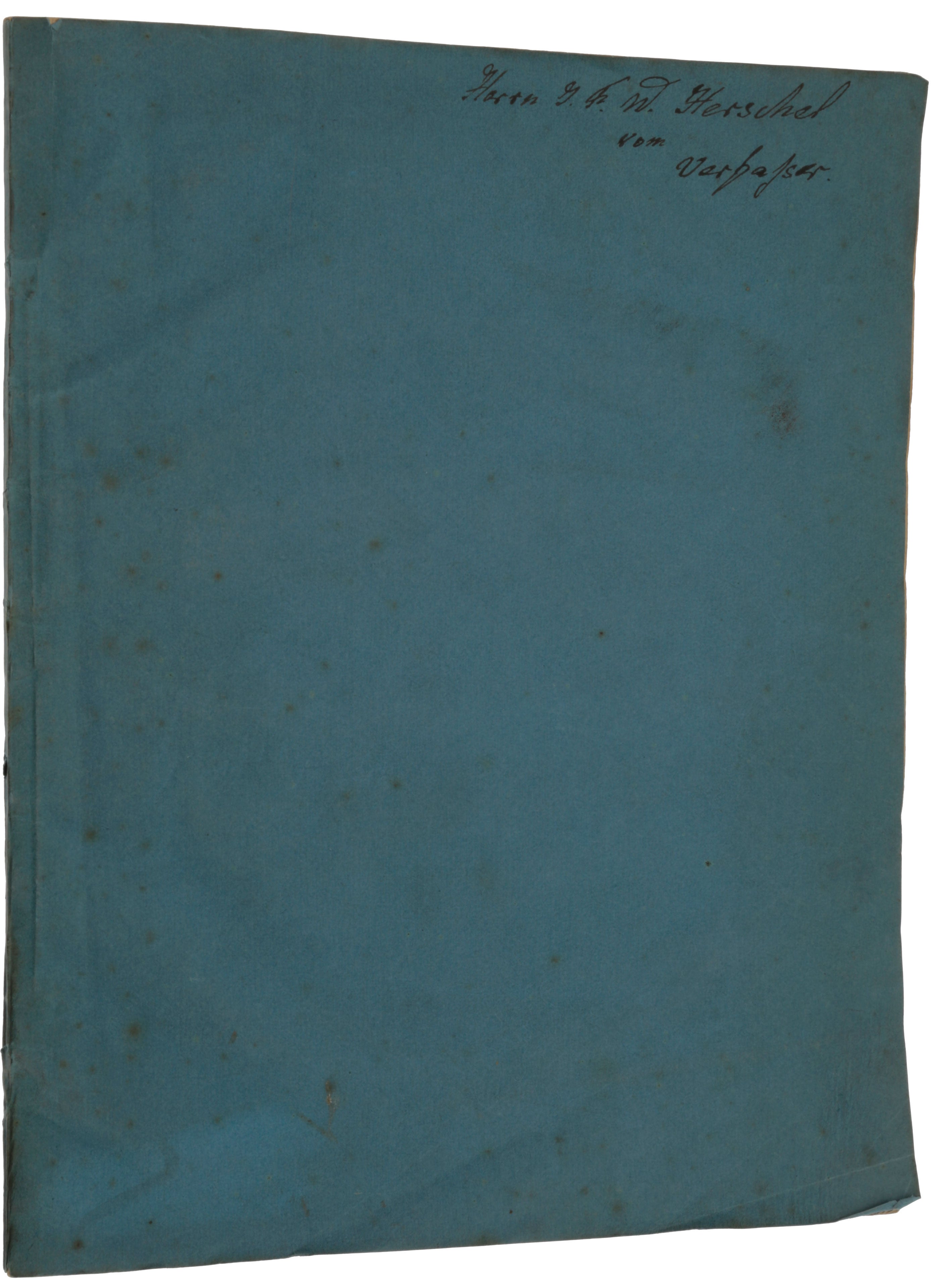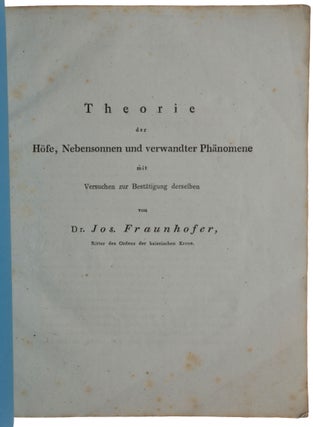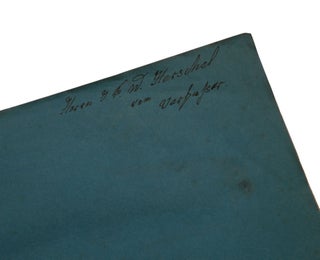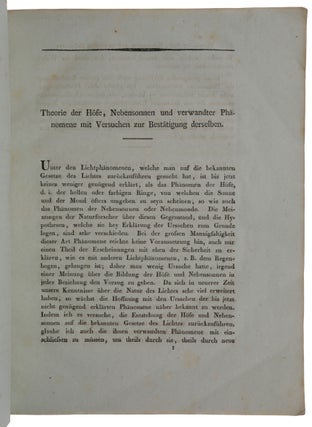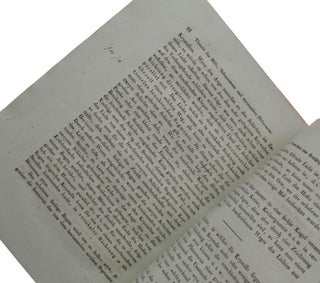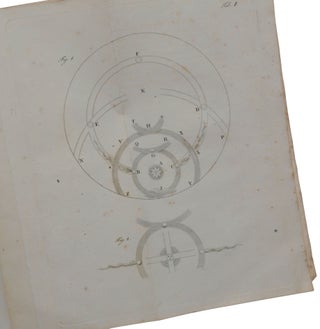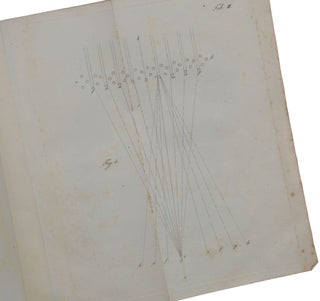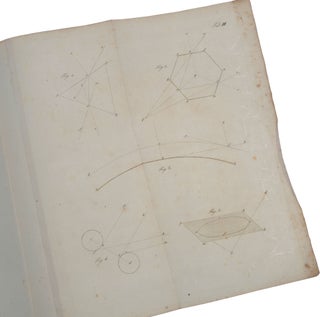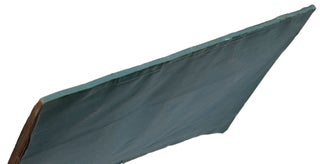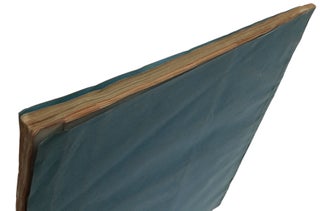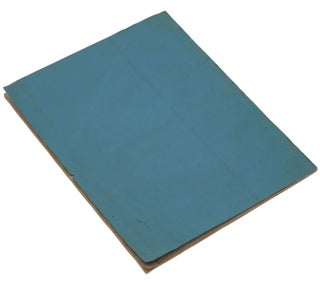Theorie der Höfe, Nebensonnen und verwandter Phänomene mit Versuchen zur Bestätigung derselben. Offprint from Astronomische Abhandlungen (H. C. Schumacher, ed.), Drittes Heft.
[Altona: Hammerich- und Heineking’schen Buchdruckerey, 1825]. First edition, extremely rare separately-paginated offprint (journal pagination 31-92), inscribed by Fraunhofer to John Herschel, of this work on atmospheric optical phenomena, including haloes and parhelia. “Fraunhofer had carried out experiments in 1825 with diffraction in disordered small gaps and particles, and developed the corresponding theory. Fraunhofer (1787-1826) was the first to interpret haloes around the sun and moon as diffraction phenomena. The fog particles that produce the aureole are transparent and Fraunhofer experimented with small glass spheres of the same size distributed on a glass plate. He found the same diffraction pattern as from holes in opaque plates” (Schroder & Wiederkehr, p. 251). Fraunhofer’s “family and early acquaintances were closely associated with the skilled craft tradition and particularly concerned with the glass and optical trades. As he acquired mastery of lens grinding, lens design, and glassmaking – through apprenticeship and independent study of optical books – Fraunhofer sought not merely to produce lenses which surpassed the best on the market but also to design and produce lenses which approached the optical ideal. In this pursuit he turned to the theoretical study of optics and light, a study which, when combined with his practical experience and understanding, ultimately made him the master theoretical optician of Europe and, as a by-product, led him to make numerous significant contributions to science” (DSB). Fraunhofer is best known today for the discovery of the absorption lines in the solar spectrum. “In 1802, when describing his new process for measuring the refraction of light, W. H. Wollaston reported the occurrence of dark lines in the solar spectrum but regarded them as simply natural dividing lines between the colours. Fraunhofer, originally not a scientist, but a practising optician, concentrated on these dark lines, and the title of his paper describes the method and purpose of his investigations: ‘Definition of the Capacity of Refraction and Colour-diffusion of various kinds of Glass’ … His achievements justify describing him as the founder of astrophysics. He charted several hundred lines, which have been known as ‘Fraunhofer lines’ ever since” (PMM). In September 1824, John Herschel travelled to Benediktbeuern, where Fraunhofer made his high-quality lenses, hoping to observe Fraunhofer’s techniques of optical glass manufacture (while there he met Fox Talbot, who was also visiting Fraunhofer at the time). Fraunhofer would not disclose his technique, but he did show Herschel how one could use the dark lines in order to construct superior optical glass. ABPC/RBH list one copy, not inscribed (Zisska & Schauer 2014). OCLC lists Oklahoma only in US. Provenance: Inscribed by Fraunhofer to the English astronomer and mathematician J. F. W. Herschel (1792-1871), with manuscript corrections to the text on pages 47, 56 and 58, probably by Fraunhofer. “Observed since antiquity, parhelia were often interpreted ominously as a divine omen, until a flurry of scientists in the seventeenth century (including Rene Descartes, Christiaan Huygens, and Giovanno Domenico Cassini) and eighteenthe century (including Isaac Newton, Joseph Priestley and Pieter van Musschenbroek) sought a natural cause. Fraunhofer … gave the topic extensive coverage in his treatise on atmospheric phenomena, Theorie der Höfe, Nebensonnen und verwandter Phänomene (1825). He begins his study by listing some notable modern accounts of parhelia, with appearances ranging from areas around Rome (1629) to Gdansk (1660), London (1796), and Dillngen (1815), a town outside Augsburg. The latter example came from Joseph Weber (1753-1831), a priest, philosopher, and professor of physics, who was lucky to witness an elaborate and colourful intersection of sun halos: ‘At 11.30, a rainbow colored circle [halo] formed around the sun at a radius of about 45°; red was on the inside, and blue was on the outside. A second, northerly circle joined itself around it, such that it intersected the first circle at two points and went straight through the sun. The circles had the same brightness as the sun, and the two points of intersection were brighter than and the same size as the sun, so that two parhelia appeared … ‘A larger, brighter, more colourful stripe appeared along the south (60° away from the sun), which was redder close to the sun and bluer further from the sun, and it revealed a piece of an even larger circle. The air was quiet, hot, and dry, with medium atmospheric pressure; the sky was lined with partially translucent clouds … The meteor [atmospheric phenomenon] was very active at midday, then faded and began to disappear at about 1.00.’ “In his diagram of the phenomenon [Tab. I], Fraunhofer shows how halos and arcs of various sizes can radiate around the sun (labelled A); where the largest complete circle and smallest circle intersect (B and C), two parhelia form, with fiery, colourful stripes extending outward like inverted rainbows (a and b). Although modern diagrams differ in the number, arrangement, and shape of these halos, Fraunhofer’s visualization captures their extraordinary magnitude and geometric complexity – like giant, cosmic eyes, staring down on lowly mortals below” (Hirsch & Feurzeig, pp. 122-4). “A parhelion, or sun dog, is a type of halo consisting of a bright spot to one or both sides of the Sun. Two sun dogs often flank the Sun within a 22° halo. Sun dogs are commonly caused by the refraction and scattering of light from plate-shaped hexagonal ice crystals either suspended in high and cold cirrus or cirrostratus clouds, or drifting in freezing moist air at low levels as diamond dust. The crystals act as prisms, bending the light rays passing through them with a minimum deflection of 22°. As the crystals gently float downwards with their large hexagonal faces almost horizontal, sunlight is refracted horizontally, and sun dogs are seen to the left and right of the Sun. Larger plates wobble more, and thus produce taller sundogs. Sun dogs are red-colored at the side nearest the Sun; farther out the colors grade through oranges to blue. The colors overlap considerably and are muted, never pure or saturated. The colors of the sun dog finally merge into the white of the parhelic circle (if the latter is visible) … Another halo variety often seen together with sun dogs is the 22° halo, which forms a ring at roughly the same angular distance from the sun as the sun dogs, thus appearing to interconnect them. As the Sun rises higher, the rays passing through the plate crystals are increasingly skewed from the horizontal plane, causing their angle of deviation to increase and the sun dogs to move farther from the 22° halo, while staying at the same elevation” (Wikipedia). “Herschel’s father [William] had viewed starlight through a prism and noted the spectral properties of light from various stars, and Herschel himself may have been shown the dark lines in stellar spectra by Fraunhofer. Herschel also had in his library all the issues of the Edinburgh Philosophical Journal in which Fraunhofer’s early articles were translated. If anyone were in the position to apply spectral analysis to starlight, it would have been Herschel. Yet Herschel’s early work with prismatic analysis represented an independent line of research based on understanding the structure of matter and its interaction with light, not on the properties of celestial objects. At the beginning of his career, Herschel investigated the optical properties of crystals. It was to find a monochromatic light source for these studies that he, like Fraunhofer, became interested in the properties of light passing through various materials. As it had for the German optician, prismatic analysis provided for Herschel a means of studying the refractive properties of glass or crystalline substances and not the properties of the light sources themselves” (Case). Case, Making Stars Physical: The Astronomy of Sir John Herschel, 2018. Hirsch & Feurzeig (eds.), The Cambridge Companion to Schubert’s Wintereise, 2021. Schroder & Wiederkehr, ‘Johann Kiessling, the Krakatoa event, and the development of atmospheric optics after 1883,’ Notes and Records of the Royal Society of London 54 (2000), pp. 249-58.
4to (245 x 192 mm), pp. [ii], 60, with 3 folding engraved plates. Printed on blue paper. Contemporary blue paper wrappers, in a protective case.
Item #5229
Price: $9,500.00

